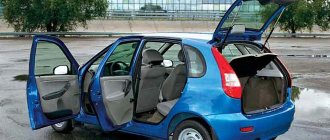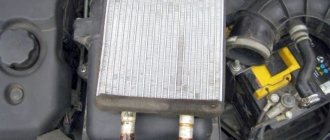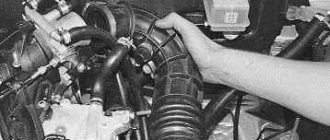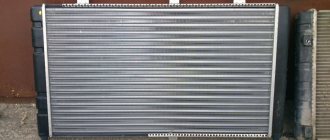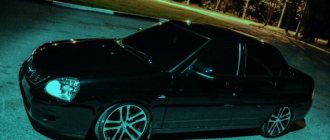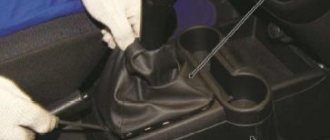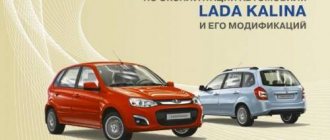In the Lada Kalina, the electronic control unit is placed thoughtlessly, since it can easily be flooded and the brains will be blown out. The designers did not think that our people could place glasses of drinks near the ECU and thereby put it at risk. But, many car enthusiasts use the technique of moving the block to a safer place.
Video on transferring an electronic control unit (ECU)
The video contains a plot and recommendations for moving the electronic control unit of the Lada Kalina to a safe place where it will not be accessible to accidental contact with liquids.
Location
The ECU on the Lada Kalina is located under the center console of the car. You can see it by removing the side cover of the front passenger's footwell air duct. The block is attached to a bolted connection and securely fixed in its place. The connectors of the unit are also tightly inserted into their place and secured with a special lock, which prevents the connector from spontaneously disconnecting from the ECU.
It is quite difficult to call this location of the engine control unit successful, since it is located exactly under the heater radiator and if there are leaks in the heater radiator, the coolant gets directly onto the engine block, which causes irreversible consequences and, of course, a breakdown or short circuit.
In some cases, there is a coolant leak at the ECU, it can be repaired, but most often it is necessary to replace the unit.
Ignition coils
If everything possible has been checked, but the car won’t start, and you don’t want to take it to the service station until you’ve tried everything that you can try to fix it yourself, check the ignition module (coil).
First, let's check the wiring. We disconnect the block of wires from the coil, connect the middle wire to the plus of the multimeter (in voltmeter mode), and connect the minus of the multimeter to ground.
If, when you turn on the ignition, a voltage approximately equal to the battery voltage appears, then everything is in order with the power supply; we check the control circuits.
To do this, connect a multimeter to the middle and one of the outer wires of the harness and turn the crankshaft with the starter - a voltage of a couple of volts should appear, similarly with the other outer wire. If the wiring is normal, check the coil.
Customized ignition coils
We switch the multimeter to ohmmeter mode, connect the tester to the middle and one of the outer terminals of the coil, if the circuit shows infinity, then that’s it - an open circuit. Same with the other extreme conclusion.
If everything is in order, we continue. We check the secondary winding - to do this, the coil must be removed from the engine and turned over. We connect the tester to the paired coil connectors - cylinders 1-4 or 2-3.
If it shows something other than infinity (should be something around 4 kOhm) then everything is fine, there is no break. Same thing with the other couple.
What kind of ECUs are there on Kalina?
Below is a table with engine controllers that were installed on the Lada Kalina.
| Manufacturer | Model | vendor code | Engine | Throttle |
| BOSCH | 7.9.7 | 21114-1411020-40 | 1.6l, 8 cl. | Mechanical |
| BOSCH | 7.9.7 | 1183-1411020-20 | 1.6l, 8 cl. | Mechanical |
| ITELMA | January 7.2 | 11183-1411020-22 | 1.6l, 8 cl. | Mechanical |
| BOSCH | 7.9.7 | 11194-1411020-10 | 1.6l, 16 cl. | Electric |
| Avtel | January 7.2 | 11183-1411020-21 | 1.6l, 8 cl. | Electric |
| Elvar | January | 11183-1411020-52 | 1.6l, 8 cl. | Electric |
| Avtel | January M73 | 21114-1411020-41 | 1.6l, 8 cl. | Mechanical |
| ITELMA | ITELMA | 21126-1411020-08 | 1.6l, 16 cl. | Electric |
Why doesn't the ECU work?
Quite often problems occur that the engine control unit stops working; to find out the reason for the failure of the ECU, you need to inspect it:
- Check to see if the connector has come loose from the unit; this happens quite often after installing a radio, or replacing a heater radiator, etc.
- Check for ground on the block. Sometimes it happens that after some work, a person forgets to fasten the mass necessary for the operation of the unit.
- Check for signs of coolant leakage on the engine block.
If such problems are not found, it is necessary to dismantle the engine block and troubleshoot, repair or replace it.
Gasoline pump
The vagaries of the fuel pump are often observed, especially in winter. The starter works, but the Kalina car refuses to start, the fuel pump cannot be heard, and an exclamation mark may flash on the dashboard.
First of all, check the pressure in the fuel system. To do this, open the hood and look for the cap on the ramp with the injectors. You can see the nipple there - if you press it, fuel should spray out. If it splashes, then the problem is not with the fuel pump.
Another reason is the relay. There is a cover in the transmission tunnel on the passenger side. It contains power coils. To eliminate the malfunction, just knock or warm them up.
If the fuel pump does not work, then you need to get to it and check the voltage. If the multimeter shows about 12 V, then the fuel pump is working. If not, then it is worth checking the fuses, as well as the relays.
Replacing the ECU
Replacing the engine controller on Kalina is quite simple according to the instructions presented below.
- Remove the negative terminal from the battery;
- Unscrew the cover of the side air duct of the front passenger's feet;
- Disconnect the connectors from the controller;
- Unscrew the screw securing the ECU on the left;
- We take out the controller by pulling it towards ourselves, as if on a sled;
- Unscrew the controller from the pad;
- Installation is carried out in the reverse order;
Source
Where is the controller on Kalina
Currently, in cars of the Granta, Kalina-2, Priora families, control units of the ME17.9.7 BOSCH and M74 brands are used.
In 100% of cases, Prioras have a BOSCH controller programmed to control the dashboard via the CAN bus. The M74, which is now installed in Grant cars (version 11186-1411020-12), has the same property.
Speaking of the configuration with the 21127 engine, behind the glove compartment of the Kalina-2 you can find a control unit called “M74”. It should be noted that the ME17.9.7 and M74 blocks are built on different hardware platforms. In this connection, the software in them is different and incompatible, although it performs the same functions. Simply replacing the controller by installing a BOSCH unit instead of M74 (M74CAN) will not work. Improvement will be required not only at the “software” level.
Itelm also has new developments of its own. For example, the M75 block, which was first released in 2012. Using the ME17.9 block, the Priora 21126 engine complies with the Euro-4 standard. It is assumed that after installing another ECU, the engine can go into the Euro-5 category. For these purposes, the M75 was developed. Moreover, this device is completely interchangeable with BOSCH ME17.9.7.
The history of ECU units produced by NPP Itelma goes back more than 14 years. The first options were intended for engines that meet Euro-2 standards, and any controller produced today controls a motor that meets the requirements of Euro-4 and higher.
Welcome! Controller - popularly it is simply called the brain, but scientifically it is briefly called the ECU, that is, the Electronic Engine Control Unit, it performs all electronic functions in the car, starting from instrument readings (Thanks to it, you understand how many revolutions it gives to the engine at one time or another, and you also understand the speed, it is only with the help of it that it is recognized, but also the sensor itself, which transmits this information to the controller) and ending with the very operation of the engine, and therefore if it fails, then all the instruments first of all stop giving readings to you and the car also won’t start, but by changing it to a new one, the car will come back to life again and will drive as if nothing had happened, but it’s best to change it to exactly the same one as it was before, it’s just that all the controllers are configured for certain sensors and for certain engines, but still, if you want, you can install a different model, but you need to make sure that the connector for the wire block in it is exactly the same as on the old one and it is desirable that it has the same dimensions, in addition, you will either have to calibrate it online, or upload a ready-made program (at your discretion and according to your financial capabilities), people also call calibration firmware so that you immediately understand what we are talking about.
Note! To carry out the work of replacing the controller on a car, you will need to stock up on: Screwdrivers, or to be more precise, you will need a Phillips screwdriver with which you will need to unscrew the screw securing the right facing, as well as a wrench you will need with which you can remove the minus terminal from the battery!
Summary:
Where is the controller (ECU) located? On all cars it is installed differently and even on Kalina cars, depending on the year of manufacture, it can be in different places, for example on Kalina 2 (We are not considering those in this article) it is located under the carpet and, unlike the first Kalina, completely in another place, on the first Kalinas, unfortunately, the controller is so poorly located that when the stove faucet fails (When it starts to leak), it begins to flood, in connection with this, all its electronics quickly perish and therefore, in a very short time, the controller becomes unusable and must be replaced, for clarity, where it is located on the first Kalinas, you can see in the photo below, the arrow indicates the right facing of the floor tunnel and if you remove it, you will see the controller before your eyes.
Note! Let us give you some advice: when buying your first Kalina, we recommend that the first thing you do is take care of the controller, namely, move it from one place to another, otherwise if the stove faucet starts to flood it, then you will have to look for money somewhere for a new one, and a new controller costs a lot money and therefore you need to take care of the one you have so that you don’t have to replace it with a new one (In this article we will also touch on the topic of transferring this part, so read everything carefully)!
When do you need to change the controller (ECU)? In fact, it’s not so easy to come across a broken controller, because they actually live almost their entire life while the car itself is driving, but it can still either burn out or, due to an unfortunate location, be completely filled with water, coolant, etc. ., maybe, like with the first Kalinas, this happens (on them the controller is located very poorly from the factory), the symptoms of its failure are the loss of communication with the ECU (That is, you connect to it and the computer simply does not see it), as well as incorrect operation of the engine, incorrect operation includes engine tripping, misfires in the ignition system, incorrect operation of fuel injectors (They can either pour and fill the engine in connection with this, or they simply turn off and will not work) and the car may not start, but after these symptoms appear on the ECU, you should think about it last, especially if you have moved it to a place where there is no moisture, just as we have already said, these control units are eternal and almost never fail.
Note! The best way to understand whether the control unit is working or has failed is to install exactly the same unit from a known-good car; unfortunately, it is very difficult to determine its condition simply by looking at it; in addition, the unit can even communicate and show that it is in the car does not have any errors, although it will not start the car itself, or it will, but the car will not work correctly and will not develop its full potential and power!
How to independently diagnose the unit?
At first glance, it may seem that diagnosing an ECU is a difficult task that not everyone can handle. Indeed, checking your block is not so easy, but having theoretical knowledge, it is quite possible to apply it in practice.
Required tools and equipment
To check the functionality of the module yourself, you will need to perform a number of steps to connect to the ECU.
To perform the test you will need the following devices and elements:
- Oscilloscope. It’s clear that not every car enthusiast has such a device, so if you don’t have one, you can use a computer with the necessary diagnostic software pre-installed on it.
- Cable for connecting to the device. You need to select an adapter that supports the KWP2000 protocol.
- Software. Finding diagnostic software today is not a problem. To do this, just monitor the network and find a program that is suitable for your vehicle. The program is selected taking into account the car, since different control units are installed on different cars.
1. Laptop for testing
2. Connection adapter
3. KWP_D diagnostic software
Algorithm of actions
The diagnostic procedure for the electronic control system is discussed below using the Bosch M 7.9.7 module as an example. This control unit model is one of the most common not only in domestic VAZ cars, but also in foreign-made cars. It should also be noted that the verification process is described using the example of using the KWP-D software.
So, how to check the ECU at home:
First of all, the adapter used must be connected to a computer or laptop, as well as the ECM itself. To do this, connect one end of the cable to the output on the unit, and the other to the USB output on the computer. Next, you need to turn the key in the car's ignition, but you do not need to start the engine. By turning on the ignition, you can launch the diagnostic utility on your computer. After completing these steps, a window with a message should pop up on the computer screen, which confirms the successful start of diagnosing malfunctions in the controller. If for some reason the message does not appear, you need to make sure that the computer successfully connected to the controller
Check the quality of the connection and connection of the cable to the unit and laptop. Then a table should be displayed on the laptop display, which will indicate the main technical characteristics and operating parameters of the vehicle. At the next stage, you need to pay attention to the DTC section (it may be called differently in different programs). This section will present all the faults with which the power unit operates
All errors will be displayed on the screen in the form of encrypted combinations of letters and numbers. To decipher them, you need to go to another section, which is usually called Codes, or use the technical documentation for your car. If there are no errors in this section, then you now don’t have to worry, since the vehicle’s engine is working perfectly (the author of the video about ECU repair at home is the AUTO REZ channel).
But this verification option is most relevant if the computer sees the block. If you have problems connecting to it, then you will need an electrical diagram of the device, as well as a multimeter. The tester or multimeter itself can be purchased at any specialty store, and the electrical circuit diagram of the ECM should be in the service manual. The diagram itself needs to be studied most carefully; this will be required for verification.
In the event that the ECM points to a specific block, and does not show erratic data, then in accordance with the diagram it needs to be found and called. If there is no accurate information, then the only way out is to diagnose the entire system; as we said above, breakdowns are considered one of the main faults.
After the breakdown is found, it is necessary to check the resistance and determine exactly where the cable is fixed. You will need to solder the corresponding new wire parallel to the old one; if the reason lies in the breakdown, then these actions will eliminate the problem. In all other cases, only qualified specialists can solve the problem.
How to replace and transfer the controller (ECU) to a VAZ 1117-VAZ 1119?
Note! When the ECU is removed, inspect it; there should be no cracks; if necessary, disassemble it by removing the cover from it (there you will need to unscrew the side screws) and when the cover is removed and the board itself is in front of your eyes, then the first thing inspect it and there should be no moisture on it and it should be in normal condition and there shouldn’t be anything torn from it either!
Removal: 1) First, turn off the power to the entire on-board network, otherwise if water gets on the controller or on the wire block when you disconnect it, it will immediately disable it, or the wires will burn out, but even without water the wires can close , so still protect yourself by removing the minus terminal from the battery for this (For how to do this, read “in this article” in paragraph 1), then from the side of the passenger seat, or to be more precise, in the place where passengers put their feet climb up and there will be a side lining of the floor tunnel on the side, it is fastened with one screw, you unscrew it and then remove the lining as shown in the small photo in the example of the left lining.
2) As soon as the right facing is removed, look for the control unit at the very bottom, it is attached with one screw to the heater body (This screw is indicated by an arrow in photo 1), you unscrew this screw and then remove the controller along the guides when it is removed , disconnect the block of wires from it, to do this, pull out the lock that secures the block to the control unit (see photo 2) and after that the block can be disconnected from the controller and thus you will have it completely removed.
Installation: The new controller is installed in the reverse order of removal, but there are some nuances during installation, firstly, the immobilizer (This only applies to the new control unit, so if you don’t change it, you don’t need to do anything) unless you have it disabled you will have to retrain (For information on how to do this, read the article: “Training the immobilizer on a VAZ”), and secondly, if you are going to install the controller in the same place (Which we do not advise you to do), then make sure that the controller brackets fit in ( The brackets are indicated by red arrows; in the photo, by the way, the heater has been removed from the car for clarity) exactly into the guides of the heater housing.
Additional video: Be sure to check out the video below, it tells you why you need to move the control unit from its regular place, and also shows where it can be secured and how all this is done.
Greetings, dear friends and readers of our site. In today’s article I would like to talk to you about the ECU controllers for Lada Kalina 1 and 2. Well, if you look into the very structure of this post, we will talk about where the ECU controller is located, how to dismantle it yourself, and of course interchangeability controllers.
Let's sum it up
If symptoms appear, the owner of LADA Kalina should contact service as soon as possible, because the cost of repairs can be significantly reduced. It is advisable to independently carry out the procedures we have indicated if the owner of LADA Kalina has a sufficient level of experience in dealing with automotive electronic devices. To do this, at a minimum, you need to know where the ECU is located, as well as how to remove the ECU. However, a 100% positive outcome of the event should not be expected. In case of failure, we recommend contacting the service specialists.
Where is the ECU controller located on the Lada Kalina
So, the Kalina engine control unit is located at the very bottom of the console, between the floor and the heating radiator. It is accessible from the passenger's feet.
To do this, you need to remove the plastic cover, which is attached with one screw. We unscrew it and move the lining forward along the direction of the car, after which it should completely disengage. We remove the cover to the side. Below it we see the following picture.
Location of the ECU controller on Lada Kalina
Why the ECU on the Lada Kalina does not work - the main reasons
One of the most common problems that Lada Kalina owners encounter is ECU failure. Let's look at the main reasons for controller failure:
- Failure due to a short circuit in the on-board network. Here, you can get by with little effort and solder the main resistors, or it will lead to complete combustion of the element.
- If liquid gets on the unit panel, which will lead to complete failure. Usually the ECU is filled with antifreeze.
- Illegal actions of third parties that will lead to ECU failure.
- Other reasons not previously stated.
All these reasons will serve as a reason for diagnosing and dismantling the car control unit.
timing belt
A terrible problem that occurs with viburnum is a broken timing belt. It is impossible not to notice this problem. It doesn’t happen that you start the car in the morning and the belt is broken.
No, the belt breaks while moving and nothing good can happen here. The valves meet the pistons and bend them, and the entire piston can often break apart, which can lead to expensive repairs.
These are all 16 valve engines; eight valve engines do not have such consequences, because the pistons have recesses for the valves, and it is these recesses that help avoid collisions between the valves and the pistons.
No one is safe from a belt rupture, just check it more often, then you can notice the threat of a rupture and replace the belt that threatens to break in time. There is also an option to install pistons with grooves in a 16-valve engine, this will also help avoid serious consequences if the belt breaks.
Another problem - the pulley turned. Occasionally it happens that it turns over two or three teeth, because of this the sensor shows the wrong phase and the engine does not start. You need to remove the belt and check whether the mark on the pulley and the rear cover of the timing belt matches.
If not, then you need to turn the pulley (in rotation) until the marks match. The work is troublesome, you need to disassemble a lot of things to get where you need to, you also need to keep track of the marks on the camshaft and crankshaft, in general there is a lot of fuss.
How to remove the ECU on a Lada Kalina - step-by-step instructions
In order to remove the ECU unit on a Lada Kalina, you must perform the following procedure:
- First you need to unscrew 2 screws, the location of the first is shown by the arrow. The second is at the same level on the engine side. Before doing this, you must remember to remove the terminal from the battery. After unscrewing the screws, do you need to pull the block towards the passenger door? and he must leave from there along the guides. Sometimes it happens that the wires rest against the carpet. Then they need to be corrected.
- In order to remove the connector and disconnect the unit from the wires, you first need to: pull the connector lock to the side. The latch is a bracket. I think you can easily find it on the connector.
Dismantling and installation of the block
Most drivers who searched for a location mainly used the glove compartment as a new location for the part. There are 2 mounting options: under the glove compartment or inside the bend of this compartment. In the first case, you will need a corner and several screws.
The procedure for obtaining the ECU:
- Armed with a Phillips screwdriver, you need to remove the panel from the front passenger seat.
- Remove the driver's side plastic panel. The block itself should now be visible.
- To remove the part, you will need to unscrew the mounting screws. Using the same screwdriver, unscrew the fasteners.
- After unscrewing the fasteners, you need to pull out the part. Pull it towards you; if it doesn’t give in, you need to move the block a little from side to side and try again. You can push it from the other side.
After the block has been removed, you can begin installing it in a new location.
Now it’s time to move on to the new installation location. The first option is quite simple:
- You will need to make a hole in the left wall of the glove compartment for a self-tapping screw.
- To mount the ECU you will need a self-tapping screw and a corner. The corner is attached to the part and secured with a bolt, screw or self-tapping screw through the glove compartment.
- On the other hand, it does not need to be secured, since it rests against the wall. The option is quite good and can be completed without unnecessary alterations within 40-50 minutes.
The second option is to store it in the glove compartment. Not the most convenient placement, but still usable. There is a small space under the glove compartment, the entire ECU can fit there.
After this, the block can be placed in a secluded corner away. You can reach this place only with a strong desire and on purpose, so the block is out of danger.
The ECU on Kalina is filled with antifreeze - what to do?
After the block filled with antifreeze has been removed, its initial inspection should be carried out. For these purposes, it is necessary to remove 4 screws using a star screwdriver. Then you should slowly remove the control board for a visual inspection. The most common failure is the burnout of the ignition coil output switch. In this case, repair will not help.
As a result of such a malfunction, the Lada Kalina starts working on only 2 cylinders, and sometimes refuses to start at all. You can cope with a similar problem in a stationary workshop. There they will remove the damaged element, wash and dry it. The second most common problem is board burnout. It is not difficult to detect such a defect: the characteristic blackening of the board will leave no doubt.
Is it possible to repair the ECU in this case? The answer to this question can only be given by a service center, but experience shows that repairs will not help here. A complete replacement is required. It happens that sometimes the brain circuitry is slightly damaged. If this happens, then the car owner can get off easy. To restore the car to working order, you will need some minor repairs:
- wipe the block with a dry cloth;
- rinse with WD-40 several times and blow it out with a compressor;
- rinse several times in alcohol and blow again with a compressor;
- dry well, otherwise the Lada Kalina will not move;
- drying takes at least 1-2 hours.
Candles
If the electronics are fine, there are still a lot of options why the engine won’t start. A common reason is that the candles are simply flooded.
Most often, candles are flooded in winter . Compression in the cold does not correspond to the parameters, so the engine does not start immediately. Often the spark plugs flood due to a weak battery that does not produce a normal spark, the wiring or the spark plugs themselves.
The easiest way to dry the spark plugs is to simply press the gas all the way to the floor and turn the engine with the starter for a few seconds (10-15). If there is nothing serious, then, as a rule, it will start (it rarely helps in winter), but if not, you will have to dry the spark plugs.
To do this, they need to be pulled out, cleaned of carbon deposits, for example with a toothbrush, the main thing is that the gap remains the same ( 0.8-1mm ), and then dried. You can use a hair dryer or even an oven if you are in a hurry.
Prudent drivers keep a spare set of spark plugs in the car for such cases. In order not to have to go to work in a minibus in the morning and not bother with drying, you can simply screw in spare candles, and in the evening, after work, calmly dry the main ones.
To reduce the risk that the spark plugs will be flooded, you need to constantly monitor the battery so that it is always charged and every two to three days, while driving, load the engine for 10 seconds to 4500-5000 rpm so that it cleans itself of carbon deposits and all sorts of deposits in the chamber.


